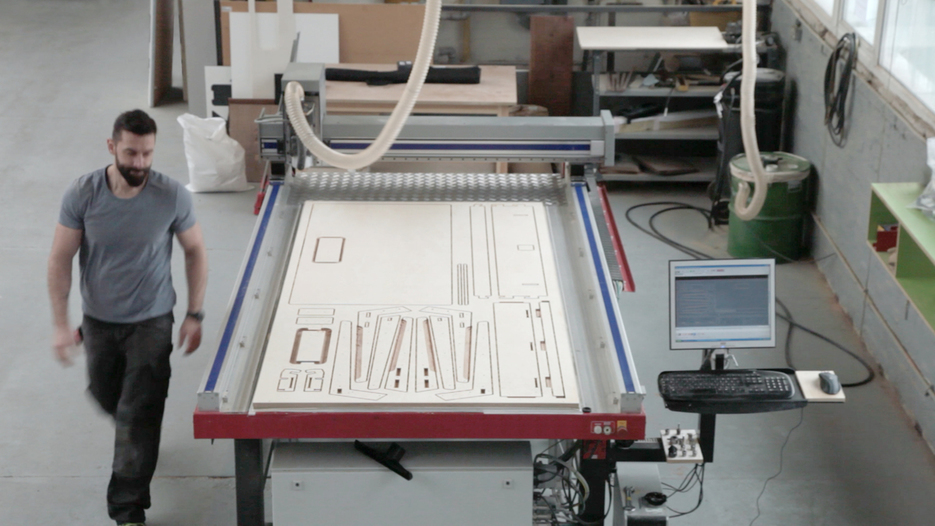CNC machines and common cut types
Our illustrated guide to CNC machining showing some of the most common processes we use – including cutting, pocketing and engraving.
The Opendesk furniture collection is comprised entirely of designs made on CNC routers. CNC routers are essentially large computer-controlled drills which can cut shapes from sheet materials – usually wood, but also plastic and soft metals.
CNC stands for computer numerical control, which refers to the tool following a path that has been programmed into a computer. These paths (lines) are drawn in CAD software by a designer, and then converted to tool paths that tell the CNC machine how to interpret each line. The machine needs to know whether it should cut right through the material, or to only cut to a certain depth. It also needs to know which side of the line the tool should run on – inside the line, on the line or outside the line.
Opendesk cutting files are designed to use 3-axis CNC machines, which are the most prevalent type. Imagine you are looking down on a sheet material; the X-axis is running left to right, the Y-axis top to bottom, and the Z-axis is plunging in and out of the material in the direction of your view.

To help explain different types of cut, we’ve put together an illustrated guide covering some of the most common cuts that are performed on a CNC machine when processing wooden sheet materials.

Cut-outside-line
Tool cuts through the material, running along the outside of a closed line in a manufacturing document/ blueprint.

Cut-inside-line
Tool cuts through the material, running along the inside of a closed line.

Chamfer-online
Chamfer tool cuts to desired depth and runs along an open or closed line, leaving an angled edge

Engrave-online
Tool of smaller diameter cuts to shallow depth and follows open or closed lines.

Fillet-online
Fillet tool cuts to desired depth and runs along an open or closed line, leaving a rounded edge.

Hole
Tool finds centre of circle and drills to desired depth at required diameter.

Pocket-inside-line
Tool pockets to required depth, milling area inside closed line.

Pocket-outside-line
Tool pockets to required depth, milling area outside closed line.

Dog-bones
Tools used on CNC machines are round and spin axially, meaning it is not possible to cut sharp inside corners. Instead, the tool must leave semi-circles on inside edges matching its diameter.
Glossary
CNC – computer numerical control
CAD – computer-aided design
Pocketing: Tool routs a defined area to certain depth and does not cut through the material.
Chamfer: Special chamfer tool in the shape of a “v” cuts into material leaving an angled edge.
Fillet: Special fillet tool shaped like a cone cuts into a material leaving a rounded edge.
This post is the first in a series of three design pieces. Read about ‘Designing for CNC Milling’ here and ‘Remastering Traditional Joinery’ here.
Also, if you’re a designer and want to see your design on Opendesk, respond to our latest brief: Open Call for Open Plan!



